Middleton W.M. (ed.) Reference Data for Engineers: Radio, Electronics, Computer and Communications
Подождите немного. Документ загружается.

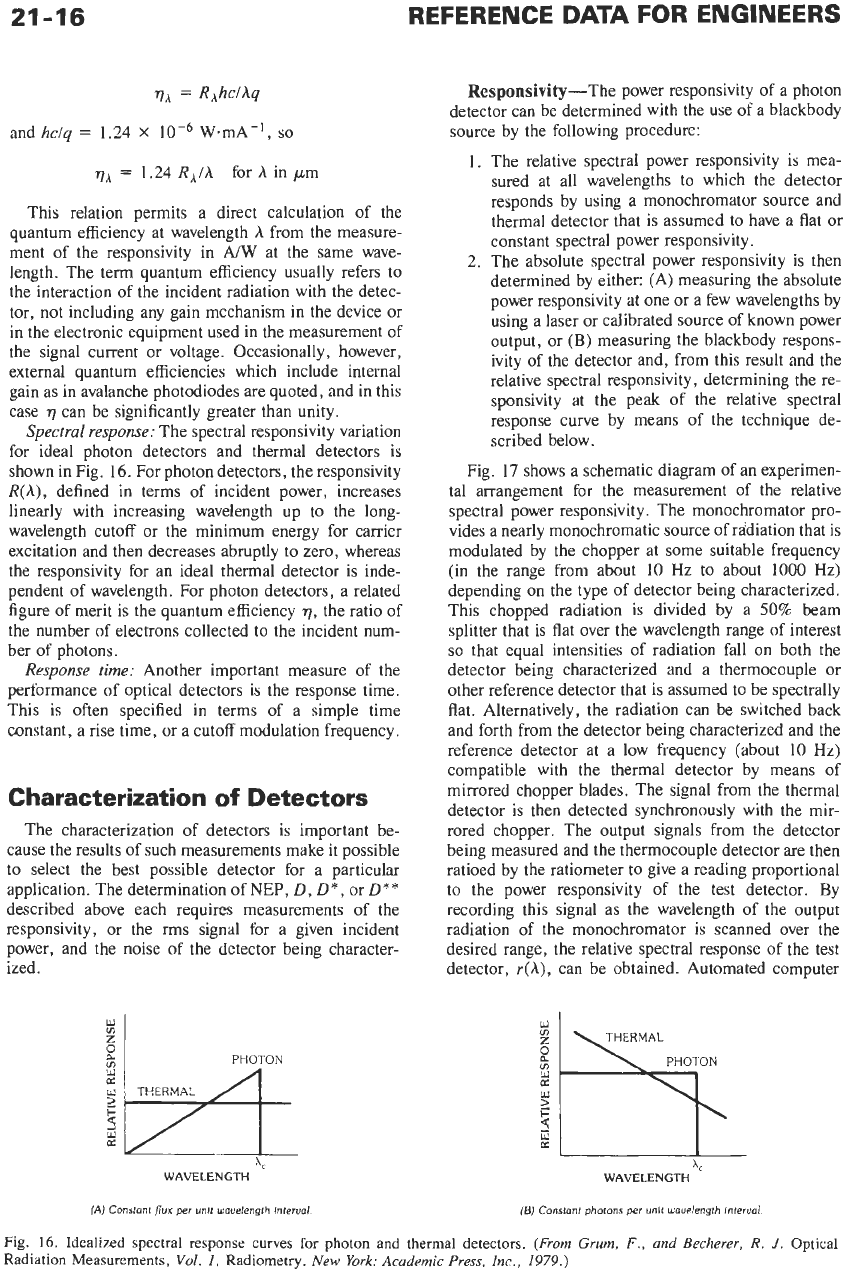
21-16
VA
=
RAhcIAq
and
hciq
=
1.24
X
loT6
W.mA-',
so
qA
=
1.24 R,iA
for
A
in pm
This relation permits a direct calculation of the
quantum efficiency at wavelength
A
from the measure-
ment of the responsivity in
A/W
at the same wave-
length. The term quantum efficiency usually refers to
the interaction of the incident radiation with the detec-
tor, not including any gain mechanism in the device or
in the electronic equipment used in the measurement of
the signal current or voltage. Occasionally, however,
external quantum efficiencies which include internal
gain as in avalanche photodiodes are quoted, and in this
case
77
can be significantly greater than unity.
Spectral response:
The spectral responsivity variation
for ideal photon detectors and thermal detectors is
shown in Fig.
16.
For photon detectors, the responsivity
R(A),
defined in terms of incident power, increases
linearly with increasing wavelength up to the long-
wavelength Cutoff or the minimum energy for carrier
excitation and then decreases abruptly to zero, whereas
the responsivity for an ideal thermal detector
is
inde-
pendent
of
wavelength. For photon detectors, a related
figure of merit is the quantum efficiency
q,
the ratio of
the number
of
electrons collected to the incident num-
ber of photons.
Response
time: Another important measure of the
performance of optical detectors is the response time,
This is often specified in terms of a simple time
constant, a rise time, or a cutoff modulation frequency.
Characterization
of
Detectors
The characterization of detectors is important be-
cause the results
of
such measurements make it possible
to select the best possible detector for a particular
application. The determination
of
NEP,
D,
D*,
or
D**
described above each requires measurements of the
responsivity, or the rms signal for a given incident
power, and the noise of the detector being character-
ized.
A,
WAVELENGTH
Responsivity-The power responsivity of a photon
detector can be determined with the use of a blackbody
source by the following procedure:
1.
The relative spectral power responsivity is mea-
sured at all wavelengths to which the detector
I
responds by using a monochromator source and
thermal detector that is assumed to have a flat or
constant spectral power responsivity
.
2.
The absolute spectral power responsivity is then
determined by either: (A) measuring the absolute
power responsivity at one or a few wavelengths by
using a laser or calibrated source of known power
output, or (B) measuring the blackbody respons-
ivity of the detector and, from this result and the
relative spectral responsivity
,
determining the re-
sponsivity at the peak of the relative spectral
response curve by means of the technique de-
scribed below.
Fig.
17
shows a schematic diagram of an experimen-
tal arrangement for the measurement of the relative
spectral power responsivity
.
The monochromator pro-
vides a nearly monochromatic source of radiation that is
modulated by the chopper at some suitable frequency
(in the range from about
10
Hz to about
1000
Hz)
depending on the type of detector being characterized.
This chopped radiation
is
divided by a
50%
beam
splitter that is flat over the wavelength range of interest
so
that equal intensities of radiation fall on both the
detector being characterized and a thermocouple or
other reference detector that is assumed to be spectrally
flat. Alternatively, the radiation can be switched back
and forth from the detector being characterized and the
reference detector at a low frequency (about
10
Hz)
compatible with the thermal detector by means of
mirrored chopper blades. The signal from the thermal
detector is then detected synchronously with the mir-
rored chopper. The output signals from the detector
being measured and the thermocouple detector are then
ratioed by the ratiometer to give a reading proportional
to the power responsivity of the test detector. By
recording this signal as the wavelength of the output
radiation of the monochromator
is
scanned over the
desired range, the relative spectral response of the test
detector,
Y(A),
can be obtained. Automated computer
.
THERMAL
WAVELENGTH
(Ai
Constant
flux
per
unlt
Wavelength Interval
(E)
Constont photons
per
unlt
wauelength interuol
Fig.
16.
Idealized spectral response curves for photon and thermal detectors.
(From Grum,
F.,
and Becherer,
R.
J.
Optical
Radiation Measurements,
Vol.
1,
Radiometry.
New
York: Academic Press,
Inc.,
1979.)
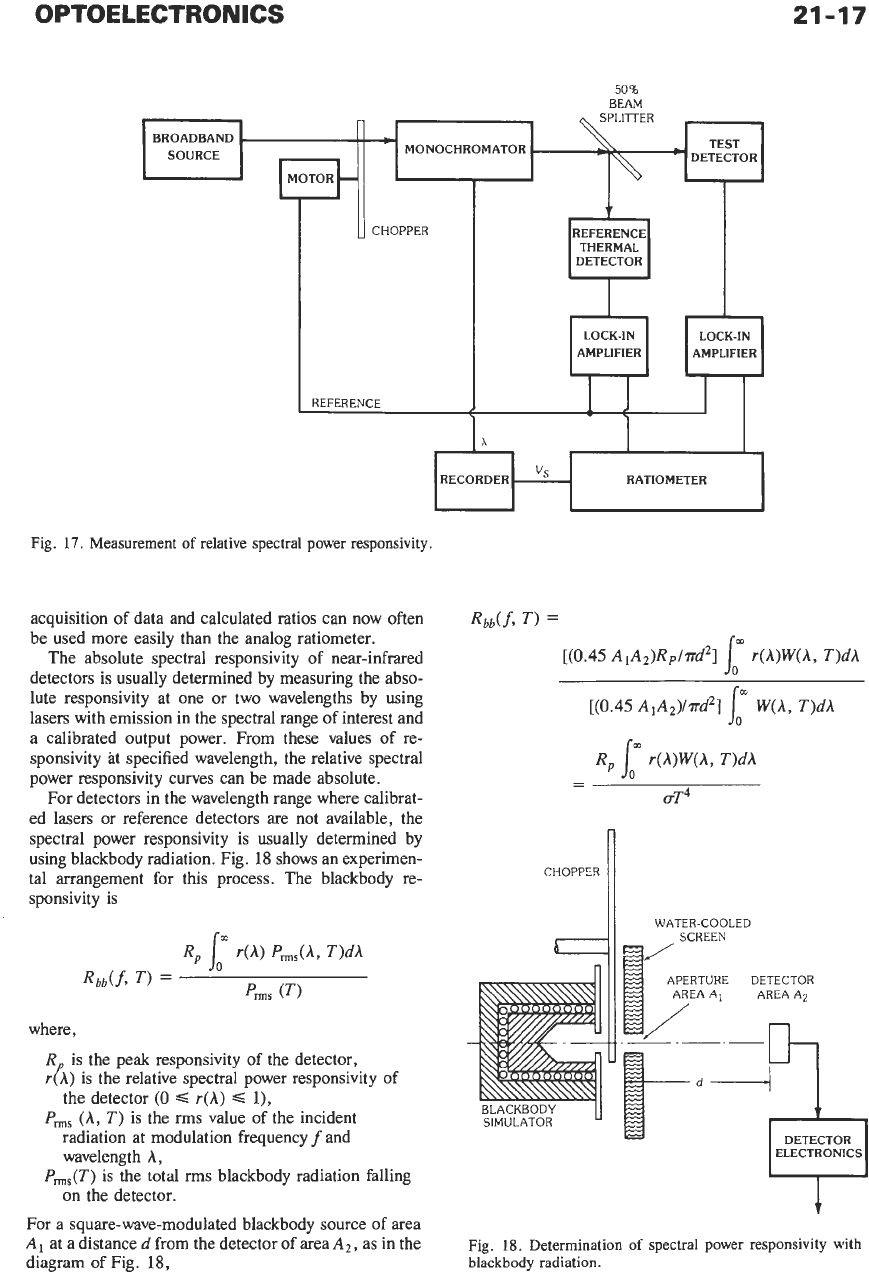
OPTOELECTRONICS
-
-
BROADBAND
SOURCE
-
21-17
MONOCHROMATOR
CHOPPER
REFERENCE
LOCK-IN
AMPLIFIER
Fig.
17.
Measurement
of
relative spectral power responsivity
.
LOCK-IN
AMPLIFIER
acquisition of data and calculated ratios can now often
be used more easily than the analog ratiometer.
The absolute spectral responsivity
of
near-infrared
detectors is usually determined by measuring the abso-
lute responsivity at
one
or two wavelengths by using
lasers with emission in the spectral range of interest and
a calibrated output power. From these values of re-
sponsivity at specified wavelength, the relative spectral
power responsivity curves can be made absolute.
For detectors in the wavelength range where calibrat-
ed lasers or reference detectors are not available, the
spectral power responsivity is usually determined by
using blackbody radiation. Fig.
18
shows an experimen-
tal arrangement for this process. The blackbody re-
sponsivity is
fm
where,
R,
is
the peak responsivity of the detector,
r(A)
is the relative spectral power responsivity of
the detector
(0
S
r(A)
S
l),
P,,
(A,
T)
is the rms value
of
the incident
radiation at modulation frequency
f
and
wavelength
A,
on
the detector.
P,,(T)
is the total
rms
blackbody radiation falling
For a square-wave-modulated blackbody source of area
A
at a distance
d
from the detector
of
area
A,,
as in the
diagram of Fig.
18,
Rbb(f,
=
[(0.45
AIA2)Rpl?rd2]
CHOPPER
A
SIMULATOR
WATER-COOLED
RTURE DETECTOR
EAAi AREAAz
WATER-COOLED
RTURE DETECTOR
EAAi AREAAz
ELECTRONICS
1
t
Fig.
18.
Determination
of
spectral
power
responsivity
with
blackbody
radiation.
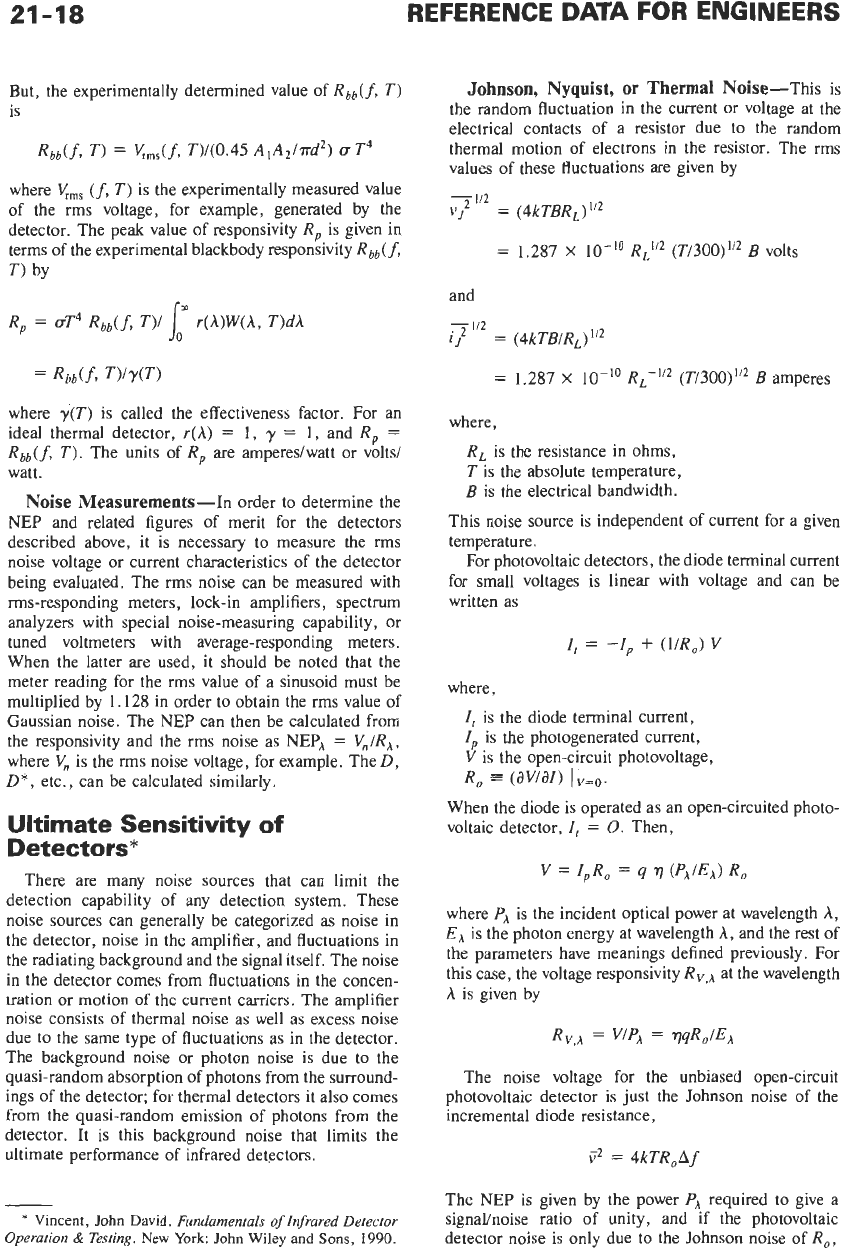
21-18
But, the experimentally determined value of
Rbb(f, T)
is
Rbb(f,
T)
=
V,,,(f,
T)/(0.45
AlA2/.rrd2)
u
T4
where
V,,,
(f,
T)
is the experimentally measured value
of the rms voltage, for example, generated by the
detector. The peak value
of
responsivity
R,
is given in
terms of the experimental blackbody responsivity
Rbb(f,
T)
by
R,
=
uT4
Rbb(f,
T)/
r(A)W(A,
T)dA
1
=
Rbb(f,
T)/.)/(T)
where
y(T)
is
called the effectiveness factor. For an
ideal thermal detector,
r(A)
=
1,
y
=
1, and
R,
=
Rbb(f,
T).
The units
of
R,
are amperedwatt or volts/
watt.
Noise Measurements-In order to determine the
NEP
and related figures of merit for the detectors
described above, it is necessary to measure the rms
noise voltage
or
current characteristics of the detector
being evaluated. The rms noise can be measured with
rms-responding meters, lock-in amplifiers, spectrum
analyzers with special noise-measuring capability, or
tuned voltmeters with average-responding meters.
When the latter are used, it should be noted that the
meter reading for the rms value of a sinusoid must be
multiplied by
1.128
in order to obtain the rms value
of
Gaussian noise. The
NEP
can then be calculated from
the responsivity and the rms noise as
NEPA
=
V,/RA,
where
V,
is
the rms noise voltage, for example. The
D,
D*,
etc., can be calculated similarly.
Ultimate Sensitivity
of
Detectors*
There are many noise sources that can limit the
detection capability
of
any detection system. These
noise sources can generally be categorized as noise in
the detector, noise in the amplifier, and fluctuations in
the radiating background and the signal itself. The noise
in the detector comes from fluctuations
in
the concen-
tration or motion of the current carriers. The amplifier
noise consists
of
thermal noise
as
well as excess noise
due to the same type
of
fluctuations
as
in the detector.
The background noise or photon noise is due to the
quasi-random absorption of photons from the surround-
ings of the detector; for thermal detectors it also comes
from the quasi-random emission of photons from the
detector. It is this background noise that limits the
ultimate performance of infrared detectors.
-
*
Vincent,
John
David.
Fundamentals
of
Infrared Detector
Operation
&
Testing.
New
York:
John
Wiley and
Sons,
1990.
Johnson, Nyquist,
or
Thermal Noise-This is
the random fluctuation in the current or voltage at the
electrical contacts of a resistor due to the random
thermal motion of electrons in the resistor. The rms
values of these fluctuations are given by
=
1.287
X
lo-'' R,"*
(T/300)1'2
B
volts
and
7
112
LJ
=
(4kTB/RL)112
=
1.287
X
lo-''
RL-li2
(T/300)1'2
B
amperes
where,
R,
is the resistance in ohms,
T
is the absolute temperature,
B
is the electrical bandwidth.
This noise source is independent of current for a given
temperature.
For photovoltaic detectors, the diode terminal current
for small voltages is linear with voltage and can be
written as
I,
=
-Ip
+
(UR,)
V
where,
I,
is the diode terminal current,
I,
is the photogenerated current,
V
is
the open-circuit photovoltage,
R,
=
(dV/dI)
IV=,,.
When the diode is operated as an open-circuited photo-
voltaic detector,
I,
=
0.
Then,
where
PA
is the incident optical power at wavelength
A,
EA
is the photon energy at wavelength
A,
and the rest of
the parameters have meanings defined previously. For
this case, the voltage responsivity
RV,A
at the wavelength
A
is given by
The noise voltage for the unbiased open-circuit
photovoltaic detector is just the Johnson noise of the
incremental diode resistance,
V2
=
4kTR,Af
The
NEP
is given by the power
PA
required
to
give a
signalhoise ratio of unity, and if the photovoltaic
detector noise
is
only due to the Johnson noise of
R,,
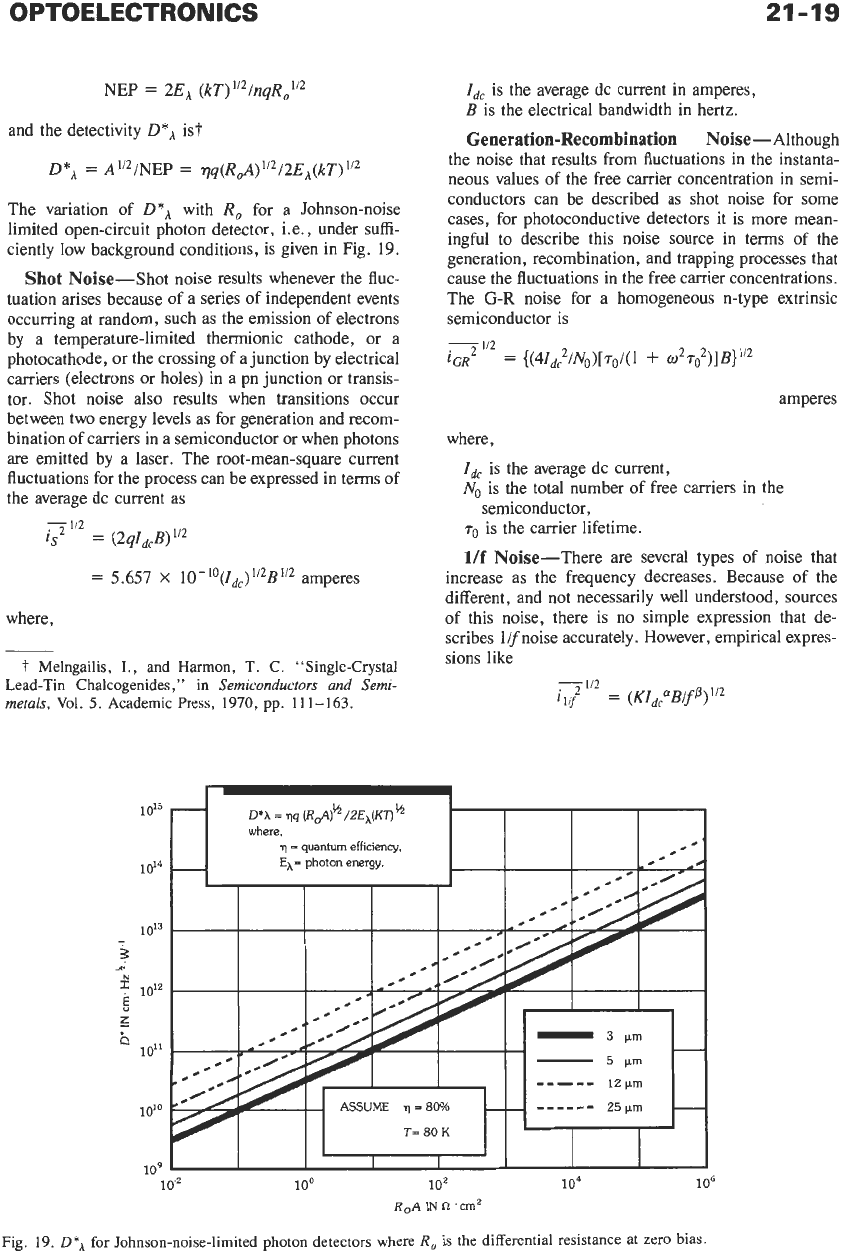
21-19
NEP
=
2EA
(kT)1’2/nqR,1’2
and the detectivity
D*A
is?
D*,
=
A”*/NEP
=
114(R,A)”2/2E,(kT)112
The variation of
D*A
with
R,
for a Johnson-noise
limited open-circuit photon detector, Le., under
suffi-
ciently low background conditions, is given in Fig.
19.
Shot Noise-Shot noise results whenever the fluc-
tuation arises because of a series of independent events
occurring at random, such as the emission of electrons
by a temperature-limited thermionic cathode, or a
photocathode, or the crossing of a junction by electrical
carriers (electrons or holes) in a pn junction
or
transis-
tor. Shot noise also results when transitions occur
between two energy levels as for generation and recom-
bination of carriers in a semiconductor or when photons
are
emitted by a laser. The root-mean-square current
fluctuations for the process can be expressed in terms of
the average dc current as
7
112
Is
=
(2qldcB)1’2
=
5.657
x
10-10(1d,)1’2B112
amperes
where,
t
Melngailis,
I.,
and Harmon,
T.
C.
“Single-Crystal
Lead-Tin Chalcogenides,”
in
Semiconductors
and
Semi-
metals, Vol.
5.
Academic Press, 1970, pp. 111-163.
10’:
1014
1013
3
*
2
1oI2
z
b
10”
1o’O
io9
Id,
is the average dc current in amperes,
B
is the electrical bandwidth in hertz.
Generation-Recombination Noise-Although
the noise that results from fluctuations in the instanta-
neous values
of
the free carrier concentration in semi-
conductors can be described as shot noise for some
cases, for photoconductive detectors it is more mean-
ingful to describe this noise source in terms of the
generation, recombination, and trapping processes that
cause the fluctuations in the free carrier concentrations.
The
G-R
noise for a homogeneous n-type extrinsic
semiconductor is
amperes
where,
Idc
is the average dc current,
No
is the total number of free carriers in the
T~
is the carrier lifetime.
semiconductor,
l/f
Noise-There are several types of noise that
increase as the frequency decreases. Because of the
different, and not necessarily well understood, sources
of this noise, there is no simple expression that de-
scribes llfnoise accurately. However, empirical expres-
sions like
-
112
ilif
=
(KIdCaB/fP)“*
q
=
quantum
efficiency,
-
3
pm
_.
5
wn
-----
12pm
__
25pm
-
ASSUME
q=80%
------
T=
80
K
I I
loo
lo2
lo4
lo6
R,A
IN
Cl
‘cm2
Fig.
19.
D*n
for
Johnson-noise-limited photon
detectors
where
R,
is
the
differential
resistance
at zero
bias.
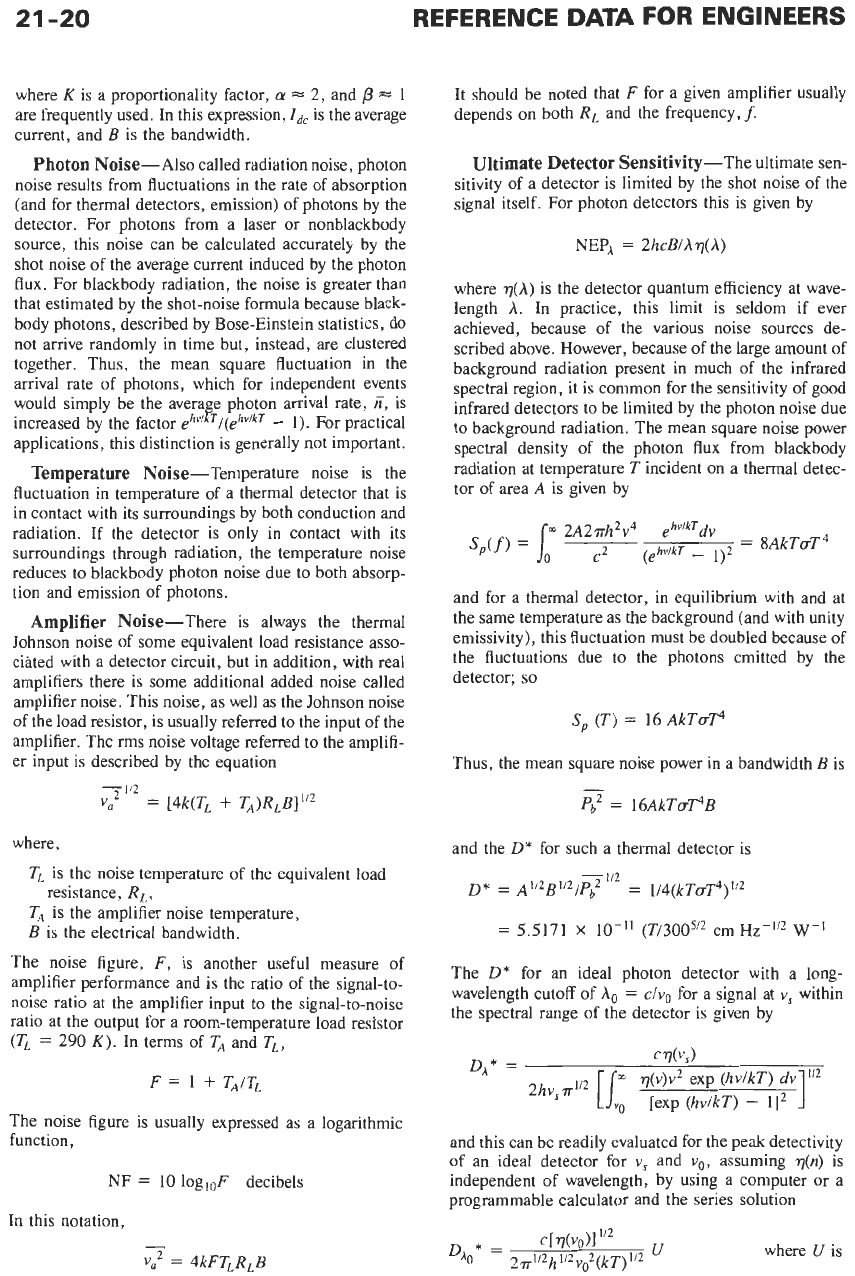
21
-20
REFERENCE
DATA
FOR ENGINEERS
where
K
is a proportionality factor,
a
-
2, and
p
=
1
are frequently used.
In
this expression,
I,
is the average
current, and B is the bandwidth.
Photon Noise-
Also
called radiation noise, photon
noise results from fluctuations in the rate of absorption
(and for thermal detectors, emission) of photons by the
detector. For photons from a laser or nonblackbody
source, this noise can be calculated accurately by the
shot noise of the average current induced by the photon
flux. For blackbody radiation, the noise is greater than
that estimated by the shot-noise formula because black-
body photons, described by Bose-Einstein statistics, do
not
arrive randomly in time but, instead, are clustered
together. Thus, the mean square fluctuation in the
arrival rate of photons, which for independent events
would simply be the avera e photon arrival rate,
E,
is
applications, this distinction
is
generally not important.
Temperature Noise-Temperature noise is the
fluctuation
in
temperature of a thermal detector that is
in
contact with its surroundings by both conduction and
radiation.
If
the detector is only in contact with its
surroundings through radiation, the temperature noise
reduces to blackbody photon noise due to both absorp-
tion and emission of photons.
Amplifier Noise-There is always the thermal
Johnson noise of some equivalent load resistance asso-
ciated with a detector circuit, but in addition, with real
amplifiers there is some additional added noise called
amplifier noise. This noise, as well as the Johnson noise
of the load resistor, is usually referred to the input of the
amplifier. The rms noise voltage referred to the amplifi-
er input is described by the equation
increased by the factor e*’’
B
T/(ehvikT
-
1).
For practical
11’2
v,
=
[4k(TL
+
TA)RLB]”*
where,
TL is the noise temperature of the equivalent load
T,
is the amplifier noise temperature,
B
is the electrical bandwidth.
resistance, RL,
The noise figure,
F,
is another useful measure of
amplifier performance and is the ratio of the signal-to-
noise ratio at the amplifier input to the signal-to-noise
ratio at the output for a room-temperature load resistor
(TL
=
290
K).
In
terms of TA and
TL,
F
=
1
f
TAITL
The noise figure is usually expressed as a logarithmic
function,
NF
=
10
logloF decibels
In
this notation,
-
VO2
=
4kFTLRLB
It should be noted that
F
for a given amplifier usually
depends
on
both
RL
and the frequency,
f.
Ultimate Detector Sensitivity-The ultimate sen-
sitivity of a detector is limited by the shot noise of the
signal itself. For photon detectors this is given by
NEPA
=
2hcB/Aq(A)
where
q(h)
is the detector quantum efficiency at wave-
length
A.
In practice, this limit is seldom if ever
achieved, because of the various noise sources de-
scribed above. However, because of the large mount of
background radiation present in much
of
the infrared
spectral region, it is common for the sensitivity of good
infrared detectors to be limited by the photon noise due
to background radiation. The mean square noise power
spectral density of the photon flux from blackbody
radiation at temperature T incident on a thermal detec-
tor of area
A
is given by
rn
2A2rrh2v4 ehvikTdv
c2
(ehvlkT
-
112
=
8AkTuT4
and for a thermal detector, in equilibrium with and at
the same temperature as the background (and with unity
emissivity), this fluctuation must be doubled because of
the fluctuations due to the photons emitted by the
detector;
so
S,
(T)
=
16AkTuT4
Thus, the mean square noise power in a bandwidth B is
pb2=
16AkTuT‘B
The
D*
for an ideal photon detector with a long-
wavelength cutoff of
A.
=
cIvo for a signal at
v,
within
the spectral range
of
the detector is given by
C77(Vs)
DA*
=
rn
q(v)v2
exp (hv/kT) dv
2hvs.rr”2
[io
[exp (hvlkT)
-
112
and this can be readily evaluated for the peak detectivity
of an ideal detector for
vs
and vo, assuming
q(n)
is
independent of wavelength, by using a computer or a
programmable calculator and the series solution
where
U
is
c[rl(vo)l”2
DAo*
=
ZTI/2h
1/ZV
0
2
(kT)”’
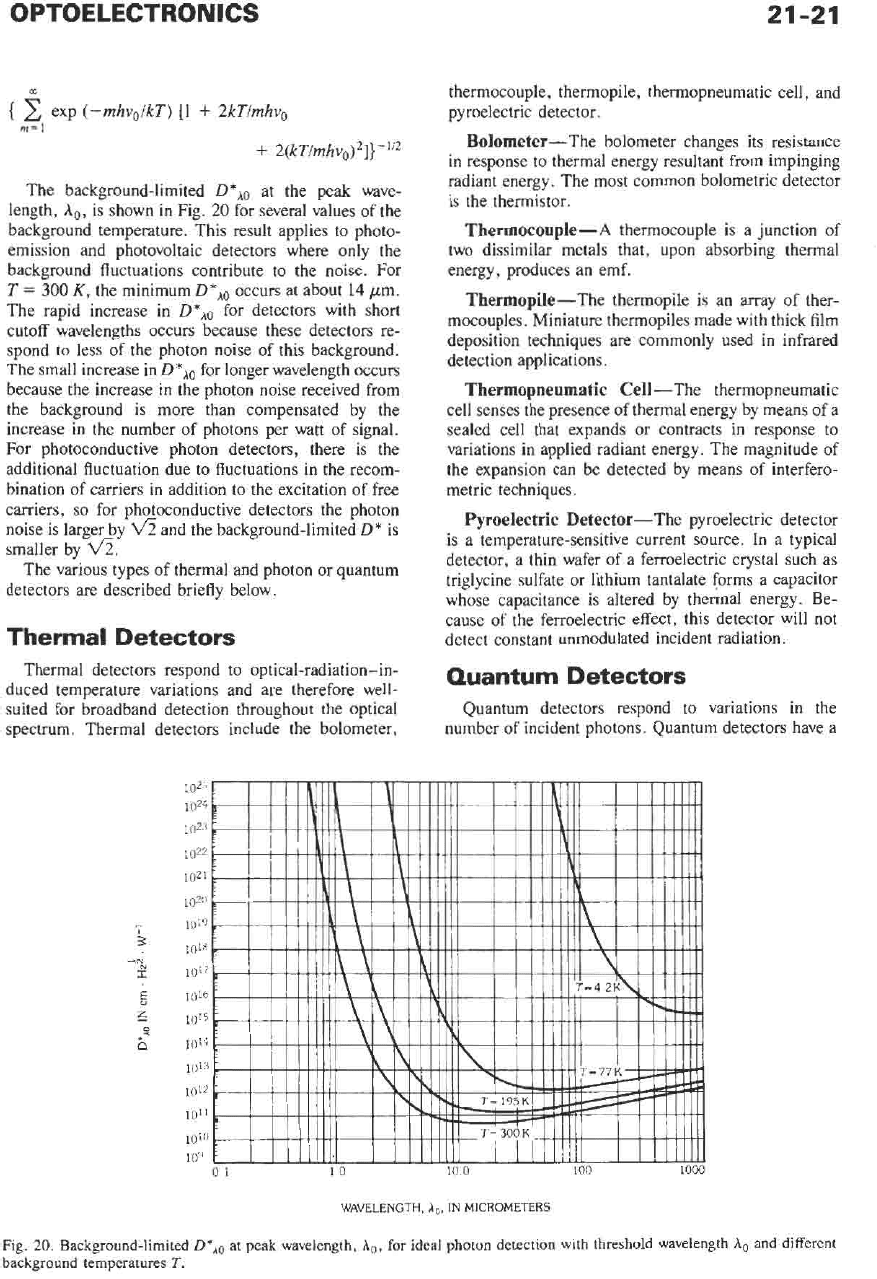
OPTOELECTRONICS
21 -21
m
{
2
exp
(-rnhv,/k~)
[I
+
2k~irnhv,
m=
1
+
2(kT/mhvo)2]}
-
The background-limited
D*,,,
at the peak wave-
length,
A,,
is shown in Fig.
20
for several values of the
background temperature. This result applies to photo-
emission and photovoltaic detectors where only the
background fluctuations contribute to the noise. For
T
=
300
K,
the minimum
D*Ao
occurs at about
14
pm.
The rapid increase in
D*,,,,
for detectors with short
cutoff wavelengths occurs because these detectors re-
spond to less of the photon noise of this background.
The small increase in
DshO
for longer wavelength occurs
because the increase in the photon noise received from
the background is more than compensated by the
increase in the number of photons per watt of signal.
For photoconductive photon detectors, there is the
additional fluctuation due to fluctuations in the recom-
bination of carriers in addition to the excitation of free
carriers,
so
for photoconductive detectors the photon
noise is larger by
fi
and the background-limited
D*
is
smaller by
fi.
The various types of thermal and photon or quantum
detectors are described briefly below.
Thermal Detectors
thermocouple, thermopile, thermopneumatic cell, and
pyroelectric detector.
Bolometer-The bolometer changes its resistance
in response to thermal energy resultant from impinging
radiant energy. The most common bolometric detector
is the thermistor.
Thermocouple-A thermocouple is a junction of
two dissimilar metals that, upon absorbing thermal
energy, produces an emf.
Thermopile-The thermopile is an array of ther-
mocouples. Miniature thermopiles made with thick film
deposition techniques are commonly used in infrared
detection applications.
Thermopneumatic Cell-The thermopneumatic
cell senses the presence of thermal energy by means of a
sealed cell that expands or contracts in response to
variations in applied radiant energy. The magnitude of
the expansion can be detected by means of interfero-
metric techniques.
Pyroelectric Detector-The pyroelectric detector
is
a temperature-sensitive current source. In a typical
detector, a thin wafer of a ferroelectric crystal such as
triglycine sulfate or lithium tantalate forms a capacitor
whose capacitance is altered by thermal energy. Be-
cause of the ferroelectric effect, this detector will not
detect constant unmodulated incident radiation.
Quantum Detectors
Thermal detectors respond
to
optical-radiation-in-
duced temperature variations and are therefore well-
suited for broadband detection throughout the optical
spectrum. Thermal detectors include the bolometer,
Quantum detectors respond to variations in the
number
of
incident photons. Quantum detectors have a
WAVELENGTH,
ho,
IN
MlCROMETERS
Fig.
20.
Background-limited
D*Ao
at peak wavelength,
ho,
for ideal photon detection with threshold wavelength
A,
and different
background temperatures
2'.
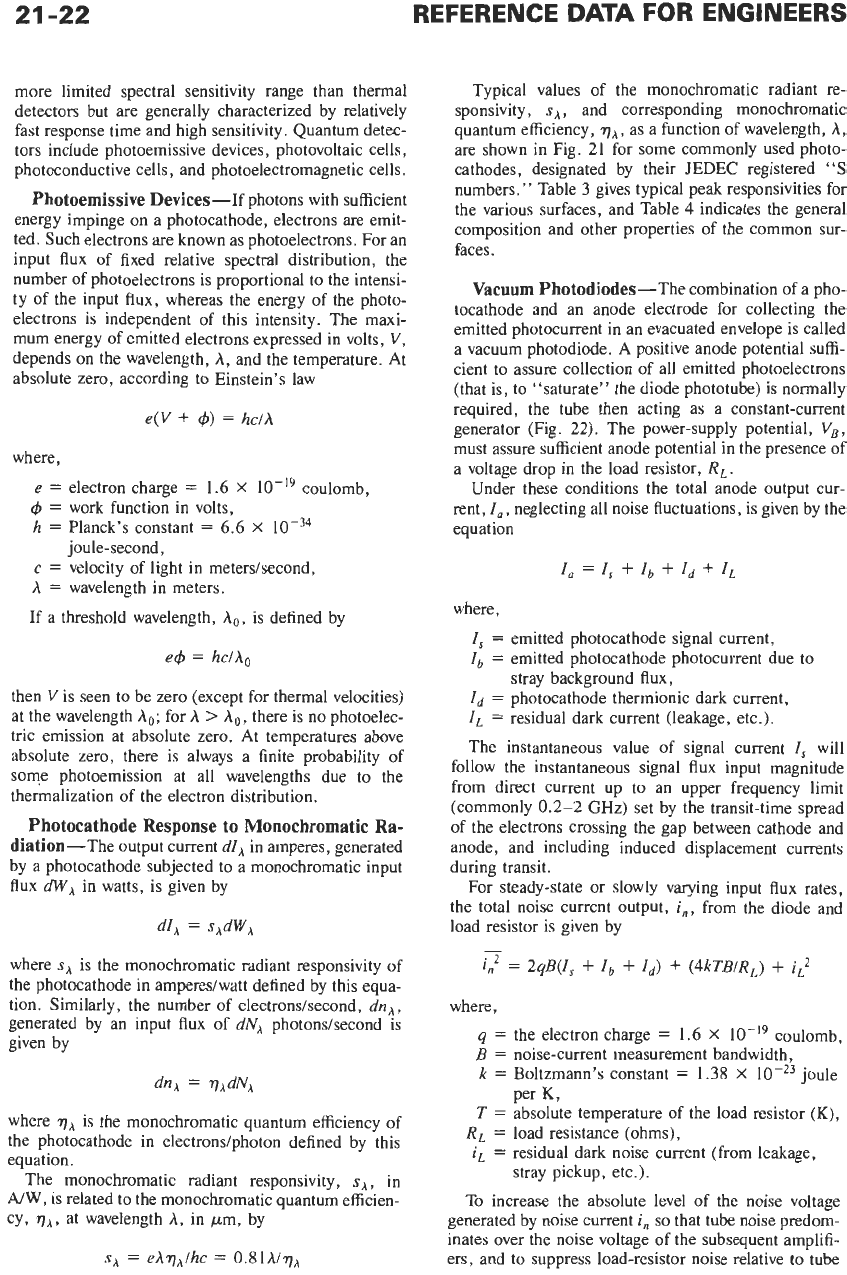
21
-22
REFERENCE
DATA
FOR ENGINEERS
more limited spectral sensitivity range than thermal
detectors but are generally characterized by relatively
fast response time and high sensitivity. Quantum detec-
tors include photoemissive devices, photovoltaic cells,
photoconductive cells, and photoelectromagnetic cells.
Photoemissive Devices-If photons with sufficient
energy impinge on a photocathode, electrons are emit-
ted. Such electrons are known as photoelectrons. For an
input flux of fixed relative spectral distribution, the
number of photoelectrons is proportional to the intensi-
ty of the input
flux,
whereas the energy of the photo-
electrons is independent of this intensity. The maxi-
mum energy of emitted electrons expressed in volts,
V,
depends on the wavelength,
A,
and the temperature. At
absolute zero, according to Einstein’s law
e(V
+
4)
=
hclh
where,
e
=
electron charge
=
1.6
X
4
=
work function in volts,
h
=
Planck’s constant
=
6.6
X
c
=
velocity
of
light in meterdsecond,
A
=
wavelength in meters.
If a threshold wavelength,
A,,
is defined by
coulomb,
joule-second,
e+
=
hc/Ao
then
V
is seen to be zero (except for thermal velocities)
at the wavelength
Ao;
for
A
>
Ao,
there is no photoelec-
tric emission at absolute zero. At temperatures above
absolute zero, there is always a finite probability of
some photoemission at all wavelengths due to the
thermalization
of
the electron distribution.
Photocathode Response to Monochromatic
Ra-
diation-The output current
dIA
in amperes, generated
by a photocathode subjected to a monochromatic input
flux
dw,
in watts, is given by
where
S,
is the monochromatic radiant responsivity
of
the photocathode in amperedwatt defined by this equa-
tion. Similarly, the number of electrons/second,
dn,,
generated by an input flux
of
dN,
photonslsecond is
given by
dn,
=
TAdNA
where
77,
is the monochromatic quantum efficiency
of
the photocathode in electrons/photon defined by this
equation.
The monochromatic radiant responsivity,
sA,
in
A/W,
is related to the monochromatic quantum efficien-
cy,
q,,,
at wavelength
A,
in pm, by
SA
=
ehqA/hc
=
0.8lA/~,
Typical values of the monochromatic radiant re-
sponsivity
,
s,,
and corresponding monochromatic
quantum efficiency,
qA,
as a function of wavelength,
A,
are shown in Fig.
21
for some commonly used photo-
cathodes, designated by their
JEDEC
registered
“S
numbers.
”
Table
3
gives typical peak responsivities for
the various surfaces, and Table
4
indicates the general
composition and other properties
of
the common sur-
faces.
Vacuum Photodiodes-The combination of a pho-
tocathode and an anode electrode for collecting the
emitted photocurrent in an evacuated envelope is called
a vacuum photodiode.
A
positive anode potential suffi-
cient to assure collection of all emitted photoelectrons
(that is, to “saturate” the diode phototube) is normally
required, the tube then acting as a constant-current
generator (Fig.
22).
The power-supply potential,
V,,
must assure sufficient anode potential in the presence
of
a voltage drop in the load resistor,
RL.
Under these conditions the total anode output cur-
rent,
I,,
neglecting all noise fluctuations, is given by the
equation
I,
=
I,
+
I,
Id
-k
I,
where,
I,
=
emitted photocathode signal current,
Ib
=
emitted photocathode photocurrent due to
id
=
photocathode thermionic dark current,
I,
=
residual dark current (leakage, etc.).
The instantaneous value of signal current
I,
will
follow the instantaneous signal flux input magnitude
from direct current up to an upper frequency limit
(commonly
0.2-2
GHz) set by the transit-time spread
of
the electrons crossing the gap between cathode and
anode, and including induced displacement currents
during transit.
For steady-state or slowly varying input flux rates,
the total noise current output,
in,
from the diode and
load resistor is given by
stray background flux,
where,
q
=
the electron charge
=
1.6
X
coulomb,
B
=
noise-current measurement bandwidth,
k
=
Boltzmann’s constant
=
1.38
X
joule
T
=
absolute temperature of the load resistor
(K),
i,
=
residual dark noise current (from leakage,
per
K,
RL
=
load resistance (ohms),
stray pickup, etc.).
To
increase the absolute level of the noise voltage
generated by noise current
in
so
that tube noise predom-
inates over the noise voltage of the subsequent amplifi-
ers, and to suppress load-resistor noise relative to tube
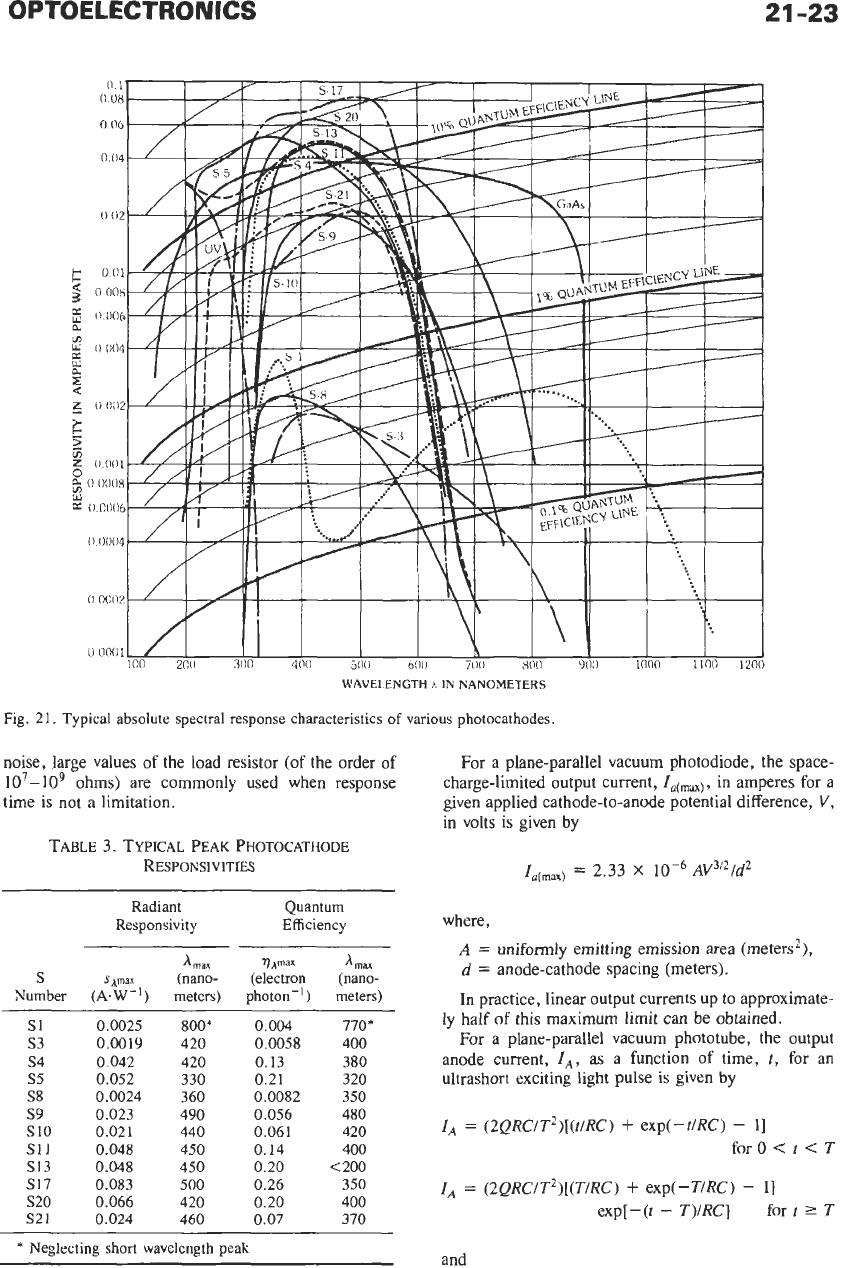
OPTOELECTRONICS
21
-23
WAVELENGTH
A
IN
NANOMETERS
Fig.
2
1.
Typical absolute spectral response characteristics
of
various photocathodes.
noise, large values
of
the load resistor
(of
the order
of
107-109
ohms) are commonly used when response
time is not a limitation.
TABLE
3.
TYPICAL
PEAK PHOTOCATHODE
RESPONSIVITIES
Radiant Quantum
Responsivit
y
Efficiency
4nax
l)Amax
hl,
S
S,pm
(nano- (electron (nano-
Number
(A.W-')
meters)
photon-') meters)
s1
0.0025
800*
0.004 770*
s3
0.0019
420
0.0058
400
s4
0.042
420
0.13 380
S5
0.052 330
0.21 320
S8
0.0024 360
0.0082 350
s9
0.023
490 0.056
480
s10 0.021
440 0.061 420
,511
0.048
450
0.14
400
S13
0.048 450
0.20
<zoo
S17 0.083
500
0.26 350
S20
0.066 420
0.20 400
S21
0.024
460
0.07
370
*
Neglecting short wavelength peak
For a plane-parallel vacuum photodiode, the space-
charge-limited output current,
la(max),
in amperes for a
given applied cathode-to-anode potential difference,
V,
in
volts is given by
I,(,,,)
=
2.33
X
AV3I2/d2
where,
A
=
uniformly emitting emission area (meters2),
d
=
anode-cathode spacing (meters).
In practice, linear output currents up to approximate-
ly
half
of
this maximum limit can be obtained.
For a plane-parallel vacuum phototube, the output
anode current,
I,,
as a function
of
time,
t,
for an
ultrashort
exciting light pulse
is
given
by
I,
=
(2QRC/T2)[(f/RC)
+
exp(-t/RC)
-
11
for
0
<
t
<
T
Z,
=
(2QRC/T2)[(T/RC)
+
exp(-T/RC)
-
11
exp[-(t
-
T)/RC]
for
t
2
T
and
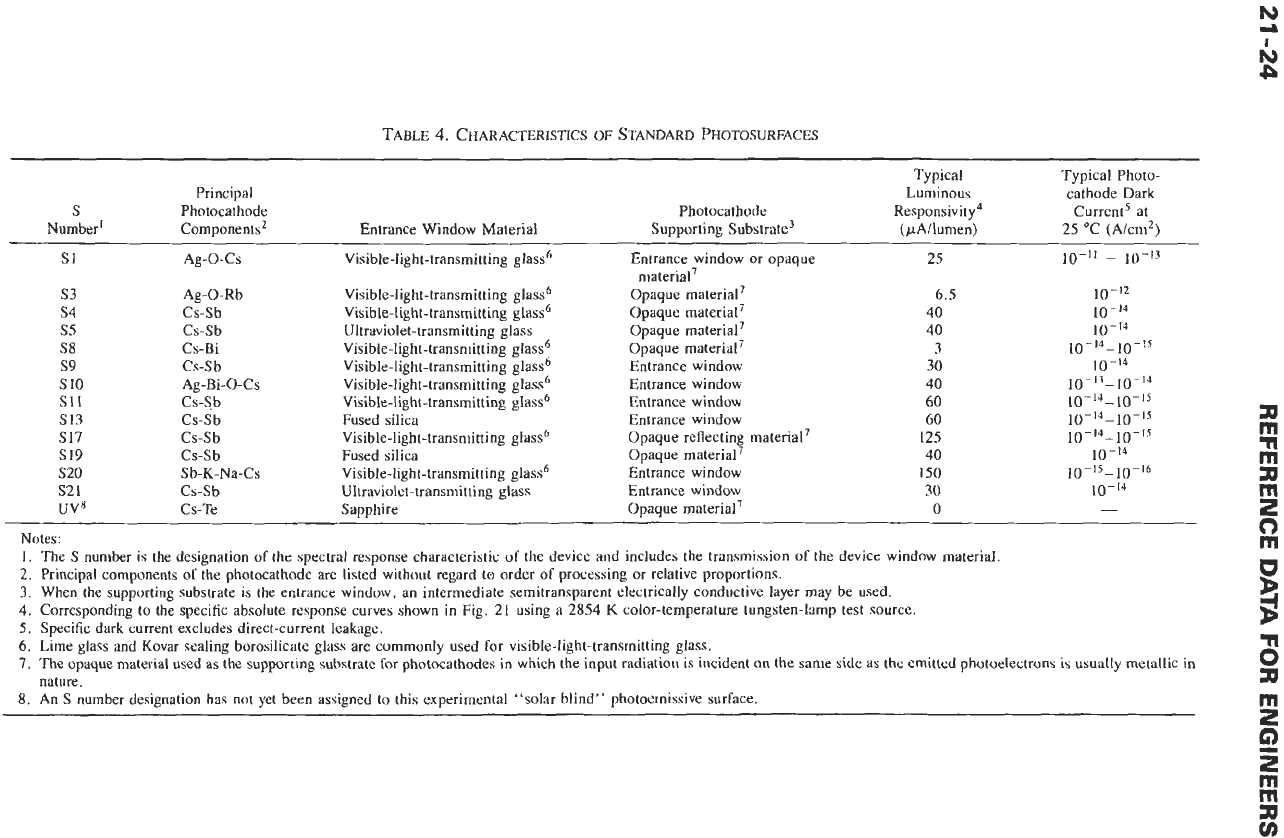
TABLE
4.
CHARACTERISTICS
OF
STANDARD
PHOTOSURFACES
Principal
S
Photocathode
Number‘ Components2 Entrance Window Material
Typical Typical Photo-
Luminous cathode Dark
Supporting Substrate’
(
pAllumen)
25
“C (A/cm2)
Photocathode Responsivity4 Currcnt5 at
25
10-11
-
10-13
SI
Ag-0-0 Visible-light-transmitting glass‘ Entrance window or opaque
material’
s3
Ag-0-Rb
Visible-light-transmitting glass6 Opaque material7
6.5
10-12
s4
Cs-Sb
Visible-tight-transmitting glass6 Opaque material7
40
10-14
s5
Cs-Sb
Ultraviolet-transmitting glass Opaque material’
40
10-14
s9
Cs-Sb Visible-light-transmitting glass6 Entrance window
30
10-14
n
rn
n
s17
Cs-Sb Visible-light-transmitting glass6 Opaque reflecting material7
125
10-’4-10-’~
SI9
Cs-Sb Fused silica
Opaque material’
40
10-14
rn
s20
Sb-K-Na-Cs
Visible-light-transmitting glass6 Entrance window
150
10-15-10-16
a
s21
Cs-Sb
Ultraviolet-transmitting glass Entrance window
30
10-14
m
z
uv8
Cs-Te Sapphire Opaque material’
0
0
Notes:
rn
U
S8
Cs-Bi Visible-light-transmitting glass6 Opaque material7
3
10-14-10-15
SI0
Ag-Bi-0-Cs
Visible-light-transmitting glad Entrance window
40
10-13-]0-’4
s11
Cs-Sb
Visible-light-transmitting glass6 Entrance window
60
10-14-1o-Is
SI3
Cs-Sb Fused silica
Entrance window
60
10-14-10-15
-
1.
The
S
number
is
the designation
of
the spectral response characteristic
of
the device and includes the transmission
of
the device window material.
2.
Principal components
of
the photocathode are listed without regard to order
of
processing or relative proportions.
3.
When the supporting substrate is the entrance window, an intermediate semitransparent electrically conductive layer may be used.
4.
Corresponding to the specific absolute response curves shown
in
Fig.
21
using a
2854
K
color-temperature tungsten-lamp test source.
5.
Specific dark current excludes direct-current leakage.
6.
Lime glass and Kovar sealing borosilicate glass are commonly used for visible-light-transmitting glass.
7,
The opaque material used as the supporting substrate
for
photocathodes in which the input radiation is incident
on
the same side as the emitted photoelectrons is
usually
metallic in
B
B
a
rn
z
nature.
8.
An
S
number designation has not yet been assigned to this experimental “solar blind” photoemissive surface.

OPTOELECTRONICS
21
-25
ANODE
Fig.
22.
Photodiode circuit.
T
=
d(2mIqV)”’
=
(3.37
X
10-6)d/(V)1’2
seconds
where,
T
=
transit time of the charge from cathode to
V
=
cathode-to-anode potential (volts),
C
=
total capacitance including external circuit
capacitance,
R
=
load resistance,
Q
=
total charge,
m
=
electron mass.
anode (seconds),
Photomultipliers-The combination of a photo-
cathode and a secondary-emission electron multiplier is
called a photomultiplier. Emitted photoelectrons from
the photocathode
are
directed under the influence of a
suitable electrode, often called the “focus electrode,”
to the surface of a secondary-emitting electrode, the
“first dynode.
”
Subsequently emitted secondary elec-
trons, increased in number by the effective secondary-
emission ratio,
(+],
are then directed to the secondary
emitting surface of a subsequent dynode by an appropri-
ate electric field for further multiplication. Continuing
this process for
n
successive dynodes and collecting the
multiplier charge at an output electrode called the
“anode” or “collector” leads to a charge or current
amplification,
G,
given by
G
=
d,
fora,
=
u2
=
u3
.
. .
=
(+
Gains as high as 105-109 are commonly achieved in
10-stage to 16-stage multipliers.
Disregarding all noise fluctuations of the output
current, and assuming operation within the usual linear-
response region,
a
photomultiplier acts as a constant-
current source generating an output current,
I,,
given by
where,
I,
=
anode signal current due to an incident signal
I,
=
anode current due to any background flux
flux to be detected,
simultaneously present on the photocathode,
Id
=
anode dark current,
G
=
current gain of the electron multiplier,
E
=
collection efficiency (ratio of current entering
the electron multiplier to emitted
photocathode current),
I,
=
photocathode signal current due to an
incident signal flux to be detected,
I,
=
photocathode current generated by any
background flux simultaneously present on
the photocathode,
I,
=
photocathode dark current,
rad
=
component of anode dark current
Id
not
originating from the photocathode.
The output signal current,
I,,
follows the instanta-
neous value of the input signal flux from direct current
up to an upper frequency limit (typically
20-200
megahertz) established by the response time or “transit-
time spread” (typically 1-10 nanoseconds).
Noise fluctuations
of
the output current in photomul-
tipliers can be divided into two classes: dark noise,
occurring in the absence of input flux, and noise-in-
signal, including “quantum” noise resulting from the
inherent quantum nature
of
the input flux as well as
uncontrolled fluctuations of that flux. The presence of
an appreciable, in fact often predominant, noise-in-
signal current component in photomultipliers depending
on the instantaneous signal current magnitude requires
caution in applying noise concepts to photomultipliers
and may lead to erroneous conclusions regarding photo-
multiplier behavior, particularly for a modulated flux
input.
For a steady-state unmodulated flux input, the total
noise current,
in,
in the load resistance,
R,
is given by
in2
=
2eGKAf(l,
+
I,
+
GEI,)
+
i:
+
(4k
TAf/R)
where,
e
=
electron charge,
K
=
photomultiplier noise factor,
measuring circuits (Hz),
current, excluding dark-current emission
from the photocathode (amperes),
load resistance
R
(amperes),
joule/K,
(kelvins).
Af
=
noise bandwidth of the noise-current
i,
=
residual photomultiplier anode dark noise
(4k
TA f/R)
1’2
=
Johnson-Nyquist noise current in
k
=
Boltzmann’s constant, 1.38
X
T
=
absolute temperature of the load resistance
For photomultipliers with a constant gain per stage,
(+,
in the first few stages of the electron multiplier, the
noise factor,
K,
may be estimated from
K
=
(+/((+
-
1)
Photomultipliers
as
Scintillation
and
Single-
Electron Counters-In combination with suitable
